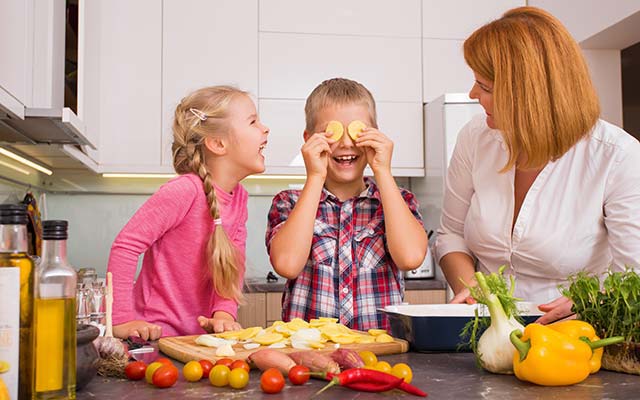There’s an art to cooking with youngsters. It’s about sharing favorite recipes. It’s about passing on family traditions. Yet it’s a forgotten art in many households. For busy parents these days, it’s tough to find time to make dinner for a family, much less include kids in the process.
As any busy parent knows, including kids in cooking meals requires time, patience, and some extra cleanup. But experts agree that it’s well worth the added effort to help children gain skills that they can use their entire lives.
Help Prevent Obesity
To help children and adolescents avoid becoming overweight or obese later in life, the American Heart Association recommends that parents engage in the following two practices (1):
- Minimize the number of meals eaten outside of the home. Through better observance and control of meals in the house, parents are able to more closely monitor the quality of the food, the way that it is prepared, and the portion sizes for their children.
- Set aside structured family meal times. While it’s not always possible, parents should try setting aside at least one night a week to come together and eat as a family. In addition, have children help prepare food so they will have a more positive attitude about meal time.
4 Tips to Cooking With Your Kids
Enlisting the help of your kids to help in the kitchen can be a little intimidating, and cause for a headache. But with the following four tips, you can take some of the stress out, and focus on the fun!
- Set your kids up for success. Structure their work areas so that they are less likely to spill or break anything and give them age-appropriate tasks.
- Set aside a time for cooking when there are no added time constraints. For example, weekends and school holidays can be a great time to do some fun activities in the kitchen with your kids.
- The easier a meal is to prepare, the more likely kids will be to want to try making them again. Try starting with things like breads, muffins, pasta, smoothies, salads, and sandwiches.
- Focus on creating balanced meals. Encourage children to serve themselves a variety of foods including fruits and vegetables (even if they won’t eat all of them).
While it’s inevitable that kids will snack on unhealthy foods like potato chips at school or enjoy some ice cream for a friend’s birthday, what’s most important is how they eat most of the time. This is where parents play a huge role. Studies suggest that when children help with meal preparation, they are much more likely to give new foods a try all on their own (2). Children who are involved in preparation also have a more positive attitude toward healthy eating, and tend to enjoy an increased variety of foods, including those dreaded vegetables (2-5).
Outside of the nutritional benefits kids gain, they also gain a sense of accomplishment for having contributed something to the family by helping prepare the meal. Most importantly, it’s a fun opportunity to pull kids away from the television or other electronics, and spend quality time together trying something new as a family.
References
- Gidding S, Dennison B, Birch L, Daniels S, Gilman M, Lichtenstein A, Rattay K, Steinberger J, Stettler N, Van Horn L. Dietary Recommendations for Children and Adolescents. Circulation. September 27, 2005, Volume 112, Issue 13. http://dx.doi.org/10.1161/CIRCULATIONAHA.105.169251
- Cooke L. The importance of exposure for healthy eating in childhood: a review. J Hum Nutr Diet. 2007 Aug;20(4):294-301.
- Cunningham-Sabo L, Lohse B. Impact of a school-based cooking curriculum for fourth-grade students on attitudes and behaviors is influenced by gender and prior cooking experience. J Nutr Educ Behav. 2014 Mar-Apr;46(2):110-20. doi: 10.1016/j.jneb.2013.09.007. Epub 2013 Nov 20.
- Ritchie B, O’Hara L, Taylor J. ‘Kids in the Kitchen’ impact evaluation: engaging primary school students in preparing fruit and vegetables for their own consumption. Health Promot J Austr. 2015 Aug;26(2):146-9.
- Cunningham-Sabo L, Lohse B. Cooking with Kids positively affects fourth graders’ vegetable preferences and attitudes and self-efficacy for food and cooking. Child Obes. 2013 Dec;9(6):549-56. doi: 10.1089/chi.2013.0076.





